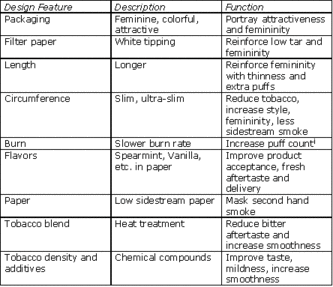Although inappropriate advertising (e.g., Joe Camel’s appeal to children) and promotions (e.g., commingling tobacco promotions with excessive drinking slogans) tend to make headlines, the tobacco industry targets special populations in a number of ways that draw less attention. These lesser known tactics might be equally effective and similarly inappropriate to their more prominent counterparts. This week, ASHES reviews a study that examined tobacco industry documents released under the 1998 Master Settlement Agreement. In this study, Carpenter, Wayne, and Connolly (2005) examined documents to determine if and how tobacco industry research on female smokers contributed to changes in product design intended to attract and retain women who smoke.
Using the online Tobacco Document Archive and British American Tobacco Document Archive, the researchers established a sample of documents by using key words related to gender, smoking behavior, product design, and specific industry research initiatives to search through the more than 7,000,000 internal tobacco industry documents. They followed their preliminary search and review of the documents with an additional keyword search based on the results of that initial search (i.e., a “snowball” sampling method). In all, the search yielded a dataset containing 320 documents that were created between 1968 and 2000.
Study of the document sample revealed that the tobacco industry was interested in recruiting and retaining female smokers. The industry action plan for gaining female smokers was to identify specific factors that made women reluctant to smoke and then to change their products to minimize those factors. Ranging from the most overt to the most hidden, Table 1, adapted from Carpenter et al., displays design features altered in the attempt to accommodate the concerns of female smokers.

Figure. Tobacco Industry Design Features for Female Smokers (adapted from Carpenter et al, 2005). Click image to enlarge.
i. Women were found to take shorter more frequent puffs, so the products were designed to enhance that smoking style.
Though the tobacco industry has examined the aforementioned design features and others, the efficacy of such changes on women today is uncertain. The most recent Tobacco Industry documents reveal that female smokers now gravitate toward more gender neutral, or “dual-sex” designs. However, the features listed in Table 1 illustrate the variety of techniques the tobacco industry attempts to make it products attractive to specific segments of the population: its not just advertising.
Notably, subtle cues can have powerful effects on individuals’ behaviors. This is true for a range of addictive behaviors, as well as for other areas of life. Marketers use this phenomenon to attract potential customers to their products. However, the subtle associations that we hold can make recovery from addiction difficult. For example, to quit smoking, some smokers also might need to change how their drinking coffee patterns because of the association between coffee and cigarettes: one is a reminder for the other. The same is true for alcohol, which is part of the reason why the commingling of tobacco promotions with excessive drinking slogans was alarming to some people. As anti-smoking initiatives move forward, it is important to recognize industry efforts to capitalize on such subtle associations. Subtle design changes could be more effective at encouraging ongoing smoking than more overt advertising and promotions.
–Debi LaPlante.
References
Carpenter, C. M., Wayne, G. F., Connolly, G. N. (2005). Designing cigarettes for women: New findings from the tobacco industry documents. Addiction, 100, 837-851.
What do you think? Please use the comment link below to provide feedback on this article.




